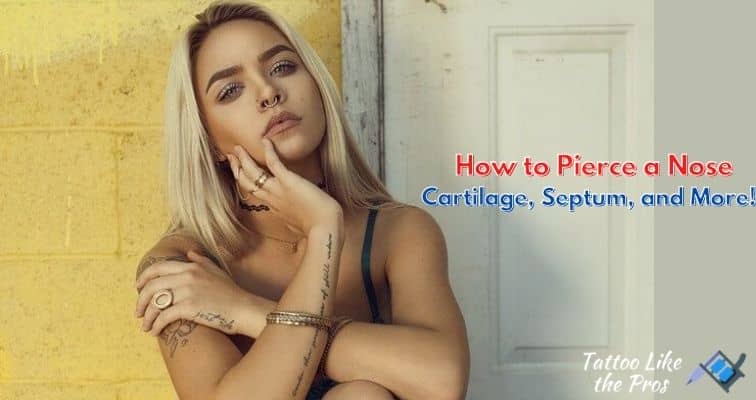Nose piercings look GOOD!
In the recent past, they have become a key expression of beauty among modern cultures.
Here is a guide on how to pierce noses that will improve your service delivery to your clients.
What are the Different Types of Nose piercings?
Almost every part of the nose can be pierced and jeweled. However, the nose septum, a cartilaginous tissue between the nostrils, is a common site for a nose piercing. Typically, the septum is pierced at its bottom end where the cartilage meets a soft tissue.
Additionally, other favorite sites for nose piercings include the right and left nostrils. Each side of the nostril can be pierced once or twice depending on the client’s specifications. And the position of the piercing can vary.
According to Jen Marie, nostril piercings are the simplest to carry out and have the widest potential of jewelry due to their readily available location.
Other types of nose piercings are variations of both septum and nostril piercings, including the nose bridge, high nostril, nasal lang and vertical tip piercings.
While horizontal bridge piercings are located high up on the nose bridge above the bone and cartilage, vertical tip piercings run from the top to the bottom tip of the nose.
Nose piercing holes vary in gauges too, depending on the client’s requirements and desired jewelry.
Nose Piercing Procedure
As a nose piercing expert, you should consider getting a license from the local authorities and checking out the legal requirements.
According to the National Conference of State Legislators (NCSL), piercing minors (persons under the age of eighteen) is prohibited in some states and others there must be legal consent from an authorized person.
Moreover, having an established premise such as a beauty shop will streamline operations and ease health inspections for you, with the added advantage of gaining more customer trust.
1. Preparation of equipment
Nose piercing tools include a hollow needle and a receiving tube to protect other areas of the face. Sterilizing chemicals such surgical spirit for the needle is a key requirement as well as antibacterial solutions for cleaning the skin area.
Moreover, you will need a pair of circular forceps for grasping the skin to conduct the piercing.
It’s important to have your client choose the desired jewel in advance. So it can be inserted in the hole immediately. This will also aid you in determining the gauge of the needle to use for the piercing since they vary in size.
Make sure you have single-use gloves for the procedure.
2. Preparation of the piercing area
Clean the skin using an antiseptic to keep infections at bay. Mark the part of the nose to be pierced with a surgical marker or pen, to guide you through the piercing process.
In case there are any hairs, trim them nicely using a single-use surgical razor blade.

3. Actual nose piercing
This is determined by the type of nose piercing your client needs. For the septum piercing, look for the “sweet spot” between the end of the cartilage and the bottom of the nose.
Avoiding the cartilage is more efficient and less painful. It also bleeds less, heals quickly and has a low probability for infections.
When piercing the nostrils, drive the needle through the skin and the flesh from inside the nostril to the outside. Make sure the needle emerges at the marked point.
Use the circular forceps to clamp the muscle and a receiving tube to guide the emerging needle.
Piercing the nose bridge and the nasallang requires a bit more care since a threaded needle is ideal for the procedure according to PainfulPleasures.com, a leading supplier of piercing and tattooing consumables.
It is recommended to pinch as much skin as possible to make a piercing that will not migrate or close up because this position is quite rigid. Moreover, be sure to use a receiving tube to protect the eyes.
4. Placing the jewelry
After the piercing, it is advisable to place sterilized jewelry in the hole to reduce bleeding and prevent closing up. Bellybling.net display a range of nose jewelry in a complete chart including barbell rings, nose hoops, straight barbells, studs and pins.
Ensure that the jewels are comfortably placed in the holes and run no risk of falling or being pulled out.
5. Healing and aftercare
There are different healing periods for various types of nose piercings. According to Piercing Models, nose piercings can take 3 to 8 months to heal completely, but with proper care.
Advise your client not to sleep on the piercing and to avoid removing jewelry before three months are over.
Furthermore, educate your client on how to clean the nose piercing using special swabs and disinfectants properly. This includes washing hands before cleaning the pierced area.
Equally important, makeup such as powder and toners should not be applied on the pierced area before complete healing.
Moreover, advise your client to avoid rotating the jewelry to avoid swelling. Dr. Donna Meltzer also warns that nasal jewelry is susceptible to swallowing and aspiration hence need for extra care. Also, the client should avoid such sports as swimming as they are likely to agitate the area and delay healing.
As a rule of thumb, advise your client to visit your beauty shop regularly so that you can check on the healing progress.
Inform them that it is better if you carry out the first jewelry swap for safety.
In case a client wants additional nose piercings, be sure to wait until all the previous piercings have healed completely.

The Bottom Line
Nose piercings carry some risks and need to be approached soberly. They are more painful than other parts of the body because the nose is more sensitive and has many nerves, but a professional piercing minimizes pain duration to about thirty seconds.
You may also like:
